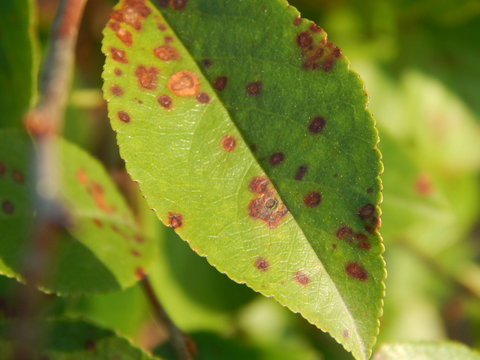Does Garden Safe Fungicide 3 Work On Cherry Leaf Spot
- Home
- Yard and garden
- Solve a problem
- Plant diseases
- Cherry leaf spot
Quick facts
- Cherry leaf spot can be a devastating disease for tart cherries.
- Leaf spot can be severe in one area and absent a few miles away.
- Leaf spots are first purple but eventually turn brown. The center of the spot may fall out and leave small holes in the leaf.
- Leaves with many leaf spots turn yellow and fall off the tree.
- Trees that lose many leaves:
- Are more likely to be damaged by winter injury.
- Grow slowly the following spring.
- Produce less fruit the following summer.
- Manage this disease by keeping your orchard clean.
- If your tree suffered total leaf loss for several years, consider using a fungicide to protect your tree.
How to identify cherry leaf spot

Symptoms
- Cherry leaf spot starts out as purple spots on the upper surface of older leaves in early summer.
- The spots grow to about 1/4 inch across and turn reddish-brown.
- The spots eventually turn brown.
- Several spots may grow together into larger dead patches.
- Yellow areas form around the leaf spots.
- The leaves start to die and fall off the tree about one month after the infection started.
- Leaf spot infections often dry up and fall out of the leaves. This results in small holes scattered across the leaf, or a "shothole" appearance.
- Purple spots occasionally forms on leaf or fruit stems but infection on the fruit is rare.
Trees likely to be affected
- In Minnesota, leaf spot can be found in plums and tart cherries.
- European plum is less likely to be affected.
- All varieties of tart cherry are likely to be affected by cherry leaf spot.
How does cherry leaf spot survive and spread?
- Cherry leaf spot fungi, Blumeriella jaapii, overwinter in infected leaves that have fallen to the ground.
- Although the leaves are dead, the fungi inside the leaves survive until the following growing season.
- The fungi start to grow in early spring when the weather is warm.
- The fungi then produce spores that are released into the air.
- Once the spores land on susceptible leaves, the spores will only germinate if the leaves are wet.
- The best temperature for infection is between 58 and 73 F.
- Young leaves aren't likely to be infected until they become completely unfolded.
- Ten to 15 days after infection, spots appear on the leaves.
- Fungal spores are produced on the lower surface of leaf spots.
- These spores are spread by wind and splashing water, causing new infections.
- In years with frequent rains in May and June, the fungi can spread extremely quickly.
- By the end of July, most cherry trees stop forming new leaves and by late summer, all the leaves are mature.
- At this time, all the leaves may become infected and trees can lose all of their leaves.
How to manage cherry leaf spot
If cherries are losing their leaves due to leaf spot, aggressive measures should be taken to control the disease.
Keep your orchard clean
- Sanitation is a critical component of cherry leaf spot control.
- Rake up and compost fallen cherry leaves in September or October.
- The fungus survives the winter in fallen leaves. Removing these leaves will reduce disease spores the next spring.
Fungicides
If your trees have dropped the majority of their leaves before September, for several years in a row, fungicides can be used to protect leaves.
- Fungicide applications should be started two weeks after bloom when leaves are completely unfolded. Applications should be repeated throughout the growing season at the interval listed on the fungicide label, including one application after harvest.
- Fungicides with an active ingredient of myclobutanil or captan will protect leaves from infection with cherry leaf spot when applied properly.
- The leaf spot fungi may develop resistance to myclobutanil if this fungicide is applied too often.
- To avoid fungicide resistance, alternate between myclobutanil and captan when making repeated fungicide applications.
- Fungicides with an active ingredient of copper may provide some protection against leaf spot infection.
- Some copper fungicides are acceptable for organic production.
- Fungicides work best if combined with sanitation.
Use Fungicides Safely
The name of the plant being treated MUST BE LISTED on the fungicide label or the product cannot be used! Some products are registered for use on ornamental Prunus species but are not safe to use on stone fruit that will be eaten. Always completely read and follow all instructions on the fungicide label.
Post harvest interval is important
Take care to wait the complete 'post harvest interval' (PHI) listed on the label. The PHI is the number of days you must wait after applying a fungicide before harvest is allowed. This time period allows fungicide residue to break down to a safe level.
Reviewed in 2019
Does Garden Safe Fungicide 3 Work On Cherry Leaf Spot
Source: https://extension.umn.edu/plant-diseases/cherry-leaf-spot
Posted by: collinsciat1966.blogspot.com

0 Response to "Does Garden Safe Fungicide 3 Work On Cherry Leaf Spot"
Post a Comment